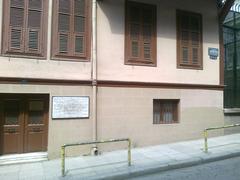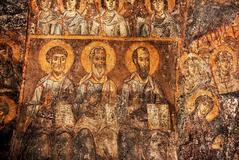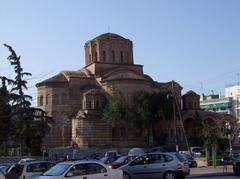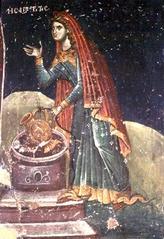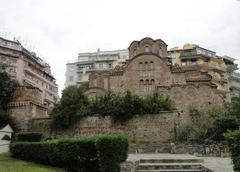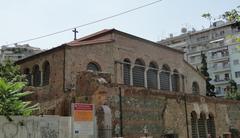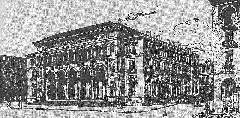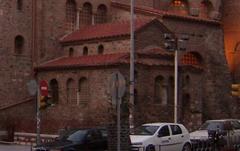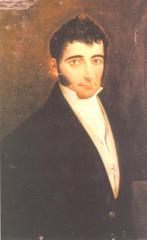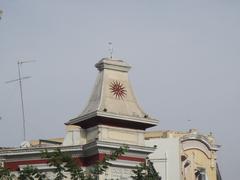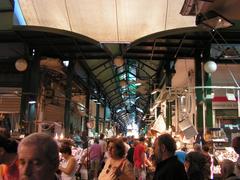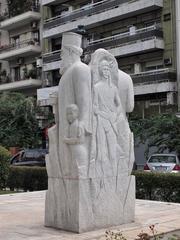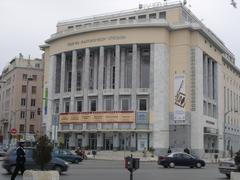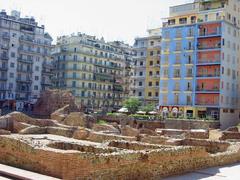Visiting Aristotelous Square: A Complete Guide
Date: 17/07/2024
Introduction
Aristotelous Square in Thessaloniki, Greece, stands as a testament to the city’s resilience and urban planning prowess. Conceived in the aftermath of the Great Fire of 1917, which devastated much of Thessaloniki, the square was the brainchild of French architect Ernest Hébrard. Hébrard’s vision transformed the cityscape, blending neoclassical and Byzantine architectural styles to create a space that honors Thessaloniki’s rich historical and cultural heritage (Thessaloniki Fire of 1917, Ernest Hébrard). Today, Aristotelous Square is not only a historical landmark but also a vibrant social and cultural hub, offering a blend of modern amenities, public spaces, and cultural events. Its central location, surrounded by iconic buildings, cafes, restaurants, and shops, makes it a must-visit destination for both locals and tourists. This guide provides a comprehensive overview of Aristotelous Square, covering its history, architectural significance, visitor information, nearby attractions, and future prospects, ensuring you have all the information you need for a memorable visit.
Table of Contents
- Introduction
- History of Aristotelous Square
- Visitor Information
- Travel Tips and Nearby Attractions
- Accessibility and Modern Challenges
- Future Prospects
- FAQ
- Conclusion
History of Aristotelous Square
Origins and Early Development
Aristotelous Square, located in the heart of Thessaloniki, Greece, is a central and iconic public space with a rich history that dates back to the early 20th century. The square was conceived as part of a grand urban planning project following the Great Fire of 1917, which devastated much of the city. The fire, which occurred on August 18, 1917, destroyed approximately two-thirds of Thessaloniki, leaving over 70,000 people homeless and necessitating a comprehensive reconstruction plan (Thessaloniki Fire of 1917).
The Hébrard Plan
In response to the destruction, the Greek government commissioned French architect and urban planner Ernest Hébrard to design a new city plan. Hébrard’s vision for Thessaloniki was influenced by European urban design principles, emphasizing wide boulevards, public squares, and monumental buildings. Aristotelous Square was a central element of this plan, intended to serve as a focal point for the city and a symbol of its rebirth (Ernest Hébrard).
Architectural Significance
The design of Aristotelous Square reflects a blend of Byzantine and Western architectural styles, a deliberate choice by Hébrard to honor Thessaloniki’s historical and cultural heritage. The square is flanked by neoclassical buildings with arcades, which provide a sense of grandeur and continuity. These buildings were constructed in the 1950s and 1960s, following Hébrard’s original designs, and have since become iconic landmarks in their own right (Aristotelous Square Architecture).
Historical Events and Transformations
Over the decades, Aristotelous Square has been the site of numerous significant events and transformations. During World War II, the square, like much of Thessaloniki, suffered damage and occupation by Axis forces. In the post-war period, the square became a symbol of recovery and modernization, hosting public gatherings, parades, and cultural events.
In the 1990s, the square underwent a major renovation to enhance its functionality and aesthetic appeal. This renovation included the installation of new lighting, landscaping, and the creation of pedestrian-friendly areas. The square’s central location and historical significance have made it a popular venue for political rallies, concerts, and festivals, further cementing its role as a vibrant public space (Thessaloniki Renovation Projects).
Visitor Information
Visiting Hours
Aristotelous Square is open 24 hours a day, making it accessible to visitors at any time. However, the best time to visit is during the day or early evening when the square is most lively.
Tickets
There is no entrance fee to visit Aristotelous Square. It’s a public space, so you can explore it freely without any tickets.
Guided Tours
While entry to the square itself is free, many guided tours of Thessaloniki include Aristotelous Square as a key stop. These tours often provide deeper insights into the history and significance of the square.
Travel Tips and Nearby Attractions
- White Tower - A short walk from Aristotelous Square, this tower is one of Thessaloniki’s most famous landmarks.
- Museum of Byzantine Culture - Offers a deep dive into the region’s rich history.
- Rotunda - An impressive Roman monument and a UNESCO World Heritage site.
- Ladadika District - Known for its vibrant nightlife and traditional tavernas.
Accessibility and Modern Challenges
Preserving the historical and architectural integrity of Aristotelous Square has been a priority for the city of Thessaloniki. Efforts have been made to maintain the square’s original design while accommodating modern needs. This includes balancing the demands of tourism, commerce, and urban development with the need to protect the square’s cultural heritage.
One of the challenges facing Aristotelous Square is the impact of increased tourism. While tourism brings economic benefits, it also places pressure on the square’s infrastructure and resources. The city has implemented measures to manage tourism sustainably, such as promoting responsible tourism practices and investing in infrastructure improvements (Sustainable Tourism in Thessaloniki).
Future Prospects
Looking ahead, Aristotelous Square is poised to continue its role as a central and dynamic part of Thessaloniki. Plans for future development include further enhancements to public spaces, improved accessibility, and the integration of smart city technologies. These initiatives aim to ensure that the square remains a vibrant and inclusive space for future generations.
FAQ
What are the visiting hours for Aristotelous Square?
Aristotelous Square is open 24 hours a day, seven days a week.
Are there guided tours available at Aristotelous Square?
Yes, many guided tours of Thessaloniki include Aristotelous Square as a key stop.
Is there an entrance fee to visit Aristotelous Square?
No, Aristotelous Square is a public space and free to visit.
Conclusion
Aristotelous Square encapsulates the spirit of Thessaloniki, blending historical significance with modern vibrancy. From its inception as part of Ernest Hébrard’s grand urban plan to its current status as a cultural and social epicenter, the square has played a pivotal role in the city’s development (Aristotelous Square Architecture). Its rich history, architectural beauty, and dynamic atmosphere make it a quintessential part of any visit to Thessaloniki. The ongoing efforts to balance tourism, commerce, and cultural preservation ensure that Aristotelous Square will continue to thrive as a central and inclusive space for future generations (Sustainable Tourism in Thessaloniki). Whether you’re drawn by its historical landmarks, cultural events, or simply the lively ambiance, Aristotelous Square offers a unique glimpse into the heart of Thessaloniki.
For more detailed information, consider downloading our mobile app Audiala, and follow us on social media for the latest updates.
References
- Thessaloniki Fire of 1917
- Ernest Hébrard
- Aristotelous Square Architecture
- Thessaloniki Cultural Hub
- Thessaloniki Renovation Projects
- Thessaloniki Urban Planning
- Thessaloniki Film Festival
- Electra Palace Hotel
- Thessaloniki Green Initiatives
- Aristotle University
- Thessaloniki Tourism
- Thessaloniki Walking Tours
- Modiano Market
- Kapani Market
- Full tou Meze
- Ergon Agora
- Mourga
- The Modernist Thessaloniki
- City Hotel Thessaloniki
- Sustainable Tourism in Thessaloniki
- Thessaloniki International Film Festival
- Thessaloniki Book Fair

